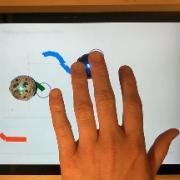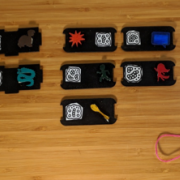Here are some elective classes you might pursue if you are considering focusing on accessibility in the Social Impact track of the ATLAS Institute master's program in Creative Technology and Design.
Wearable Technology
Introduction to basic elements of embedding electronic and computational behaviors into clothing and accoutrements such as watches and handbags. The first two thirds of the class (roughly ten weeks) comprises weekly "lab" exercises as well as associated readings and video viewings. In each exercise, participants build one of the "canonical" wearable projects (e.g., an LED-infested wearable, a glove controller, a wearable to provide navigation support for the blind and visually impaired). Readings and video viewings ensure that participants are aware of past and current trends in wearable technologies, ranging from materials, components, fashion and social acceptability, and more. The final third of the class is devoted to designing, developing, debugging and documenting a wearable technology project — developing one of the weekly exercises or inventing a new project.
Spectrum Management
Studies how spectrum policy is developed and implemented. A general framework is developed for understanding telecommunications law and regulatory objectives. Specifically analyzes international and domestic dimensions of spectrum policy. Considers how economics, administrative processes and innovative technologies affects management of the spectrum.
Human-Robot Interaction
Robots are increasingly moving from factory floors into our homes, hospitals and cities. This introduced a paradigm shift in robotics research, as co-location of humans and robots (in space and time) requires for robots to be safe and dependable around people. To this end, the emerging field of Physical Human-Robot Interaction (pHRI) brings together insights from robotics, control, human-computer interaction, haptics, human factors, cognitive sciences, interaction design and others to develop human-aware and human-oriented robot control systems and algorithms. This course will introduce students to the fundamentals of pHRI, through readings and discussions on seminal and recent papers in the field. We will cover topics such as: software and hardware safety in pHRI, human-friendly robot design, human-in-the-loop robot control algorithms, motion planning for human environments, haptics and tactile perception, rehabilitation and assistive technologies, tele-robotics and shared control. In addition, students will engage in a group project resulting in the implementation of pHRI principles on a real robotic hardware.
Accessible Web Design
This is an intermediate level course for designing web sites and digital material which are not only accessible for persons with disabilities but also effective and usable across the spectrum of user abilities and backgrounds and the variety of device platforms. This course will review standards and guidelines for usability and accessibility, focusing on the concepts of Universal Design, the Web Content Accessibility Guidelines and accessibility best practices. As an intermediate level course students should be familiar with the basic concepts of web accessibility, such as the importance of structured and semantic web design. This course will cover the specific HTML markup, CSS and JavaScript for designing accessible sites.
User-Centered Design
Develops the skills and practices necessary to apply user-centered approaches to software requirements analysis, and the design and evaluation of computer applications.
User-Centered Design & Development 1
Surveys the theoretical and practical foundations of human-computer interaction and user-centered design. Students learn theories of interaction (including cognitive, organizational, collaborative, and task-based approaches), user interface design techniques, design guidelines, and usability testing in the context of developing technology. Course content is explored through a variety of interfaces (desktop, mobile, touch, vision, audio, etc.) and contexts (personal, organizational, cross-cultural, etc.).
Input Interaction & Accessibility
Explores input and interaction techniques, with an emphasis on universal design and alternative interfaces. Students will explore traditional input methods such as keyboard and mouse input, and alternative techniques such as voice and eye gaze. Students will conduct performance evaluations of existing techniques, and prototype new interaction methods. Students will design technologies to support people with varying abilities and disabilities.






